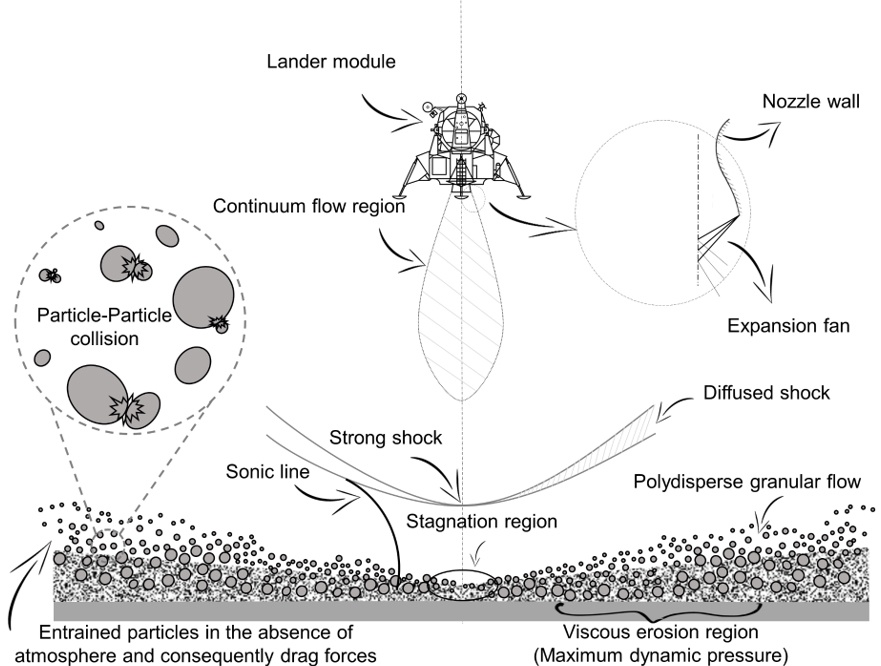One of the most iconic events in history is Apollo 11 landing on the lunar surface. During the descent, astronauts Neil Armstrong and Edwin “Buzz” Aldrin are heard relaying commands and data back and forth to mission control across 385,000 kilometers (240,000 miles) of outer space as the lunar module “Eagle” slowly inched its way into the history books.
In the final moments before touchdown, Aldrin can be heard saying, “Picking up some dust”, followed by large dust clouds shooting outward from underneath from the spacecraft as the exhaust plumes interacted with the lunar surface, more commonly known as brownout or brownout effect. This significantly reduced the visibility for Armstrong and Aldrin as they landed, and while they successfully touched down on the Moon, future astronauts might not be so lucky.
Better understanding brownout is exactly what a team of researchers from South Korea examined in a recent study published in Physics of Fluids as they developed a model to help assess safe and practical means to land a human-piloted spacecraft on a planetary surface, and this study helps complement NASA’s plume surface interaction (PSI) project.
Brownout is important to understand as humanity continues to venture to other worlds. This begins with the upcoming Artemis missions to the Moon, specifically Artemis III, which is slated to land on the lunar surface sometime in 2025. As Armstrong and Aldrin experienced during the Apollo 11 landing, brownout can significantly hinder a pilot’s visibility.
“Understanding the interaction between the rocket plume and the surface is important for the safety and success of space missions in terms of contamination and erosion, landing accuracy, planetary protection, and engineering design, as well as for scientific understanding and future exploration,” said Dr. Byoung Jae Kim, who is an assistant professor in the School of Mechanical Engineering at Chungnam National University, and a co-author on the study.
For the study, the researchers used computer models to simulate landing on the lunar surface and input data about the rocket, rocket engines, surface topography and composition, all in a near-vacuum. The simulation estimated the size and shape of the exhaust plume and the amount of brownout a pilot would see while descending towards the surface in their spacecraft.

In the end, the model showed the researchers that brownout effect for both ascent and descent was greater with small regolith particles as they experienced higher altitudes, whereas larger regolith particles with enlarged bed height (thickness) resulted in more desirable brownout conditions.
“The insights gained from this study of the effects of different parameters on plume-surface interaction can inform the development of more effective and efficient landing technologies,” said Dr. Kim. “The study also sheds light on the festooned scour patterns that can be observed on planetary surfaces, which can provide valuable information for future scientific investigations of planetary bodies.”
Aside from landing spacecraft on planetary bodies, the researchers believe their model can be used for other physics-based application, such as needle-free drug delivery systems. Going forward, the researchers plan to incorporate more data into the simulations, such as solid particle collisions and chemical reactions, in hopes of enhancing the model’s capabilities.
While the study focused on a lunar landing, the Moon and Earth aren’t the only places where brownout is experienced, as severe brownout was observed upon NASA’s Perseverance rover landing on Mars in February 2021, and more recently with NASA’s Mars Ingenuity helicopter. As seen in exclusive NASA video, the Perseverance rover became completely enveloped by Martian dust as the sky crane released it upon touchdown, while the brownout created by Ingenuity was observed to be light and short-lived. With Mars being a far dustier place than the Moon, these experiences demonstrate that brownout could pose significant problems for future Mars astronauts, as well.
While this most recent study examined a myriad of factors that contribute to brownout, what steps can be taken to mitigate it? On Earth, helipads are used so pilots can have maximum visibility when landing, but what about on other worlds? Can we build landing pads on the Moon and Mars, as NASA recently reported it wants to do in collaboration with the commercial sector?
The upcoming Artemis missions to the Moon are expected to teach us much more about living, and landing, on the Moon than the Apollo missions, and what new landing techniques, or technologies, will we learn as these missions slowly take hold in the next few years? Only time will tell, and this is why we science!
As always, keep doing science & keep looking up!


Apollo lunar landings shut down the engines 1-2 m above the surface. The martian sky crane improves on that to use a 8 m nozzle-to-surface distance. And initial descriptions has Artemis III use top mounted thrusters during the landing phase so will have about 40 m between nozzles and surface. If that works, I assume that mode will be tried on Mars at twice the gravity force.
Hopefully they will build landing pads for the second entrance to lander, which will be used much later* and whose preliminary design has just been shown in media. Like the first entrance of Artemis III is a high stack but – if tank placement is anything to go from – the engines may be placed much lower and possibly below the low riding crew compartment. (The crew will have to manage a short ladder, there will be no luxury with a crew and cargo lift as in Artemis III.)
*Initial assessment is that SLS funding issues will push the alternative lander use into the 2030s.
I’ll add that the Moon derived landing methods are possibly only used for initial landings. Landing pads would allow the use of main engines, which could leave more manoeuvre margin and be safer (perhaps especially during some martian weather conditions).